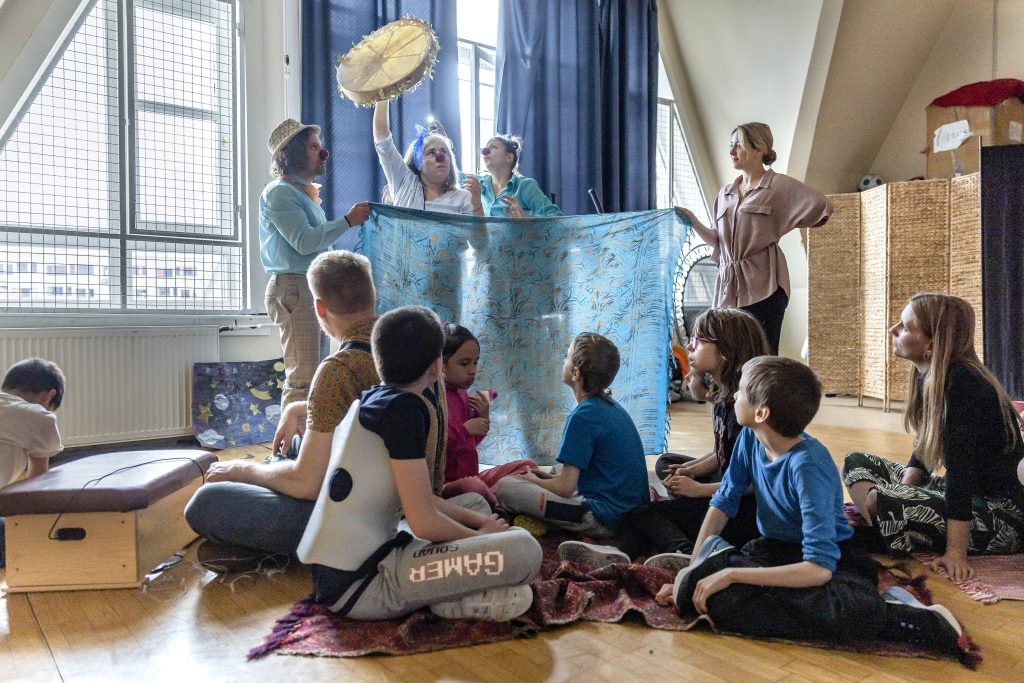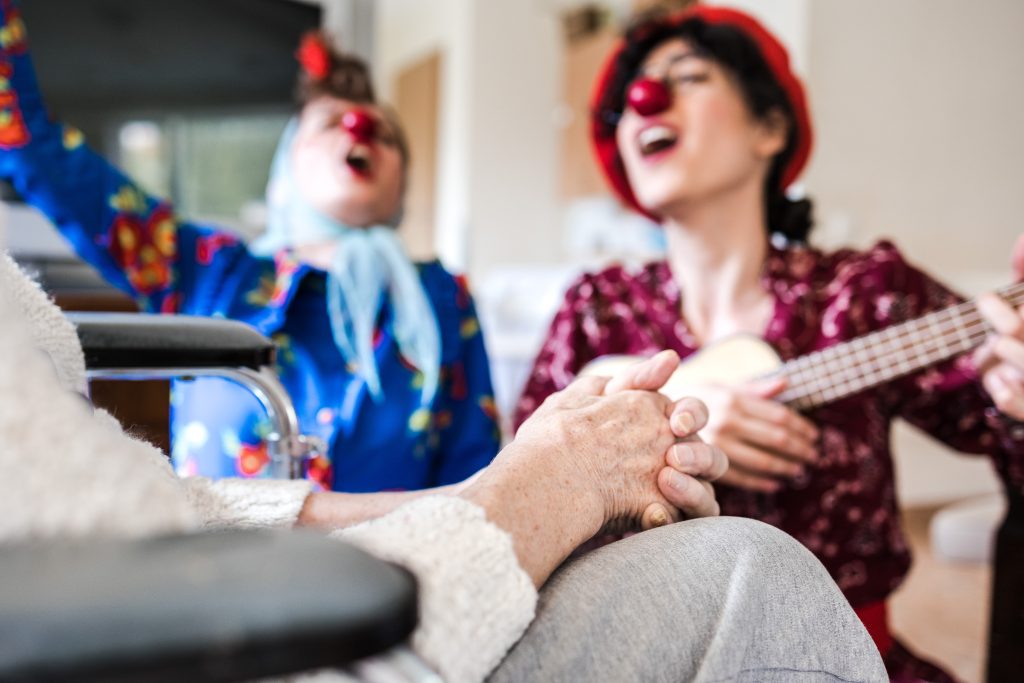© Saulius Aliukonis

Clowning Connects Us, or ClowNexus, is a project that has taken place over the course of three years (2020-2023) to explore how arts and humour, particularly the art of healthcare clowning, can be used as tools to connect and engage with two audiences, children with autism and people with dementia.
In 2019, at the annual meeting of the “European Federation of Healthcare Clowning Organisations” eight healthcare clowning organisations decided to explore how creativity and humour could be utilised to connect with people with dementia and children with autism.
Having previously spent time with children with autism and people with dementia while working in hospitals and personal care homes, the project partners and their artists observed a need to develop tailor-made artistic approaches that adapt to the specific circumstances of these groups.
Access to arts and culture is recognised as an integral part of the development of every human being. Arts and culture encourage active participation in society, and every one of us has the right to access them.
This is also enshrined in the United Nations´ Conventions, such as the UN Convention on the Rights of the Child and the Rights for people with Disabilities.
But, too often, people with special needs face barriers when it comes to enjoying an active cultural life. This may be due to physical barriers that limit or prevent participation in mainstream culture or a lack of tailor-made approaches that consider special needs, talents, and wishes.
Today, social isolation and disconnection are prevalent challenges. During times of crisis, creativity and humour become essential sources of resilience that unite people.
Artistic and humorous approaches can have a profound and positive impact on emotional well-being, communication skills, cognitive abilities, and overall quality of life.
Interacting with healthcare clowns offers alternative avenues for expression and engagement, addressing the unique needs and capacities of individuals, promoting personal growth, and fostering connections with others.
© Koncz Màrton

Children with autism like to engage in activities with others, they like creativity, enjoy laughing and can appreciate new experiences.
In all our experiences and exchanges with experts throughout this project, our belief that children with autism are just like all other children was confirmed. Children with autism can enjoy activities with healthcare clowns when they are adapted to their needs and wishes.
Anna Reenkola, a nurse from Finland talks about our work with children with disabilities:

By loading the video, you agree to YouTube's privacy policy.
Learn more
Healthcare clowns are specifically trained to sense and find out what is needed by the person they encounter through moments of connection. With this information, the clowns are able to spontaneously adapt and improvise their interactions and adapt their performances according to the reactions of their audiences.
RED NOSES Artistic Director, Christophe Dumalin, explains the work of clowns with children with disabilities:

By loading the video, you agree to YouTube's privacy policy.
Learn more

By loading the video, you agree to YouTube's privacy policy.
Learn more
This makes the art of clowning a great versatile art form for engaging with particularly sensitive audiences.
In terms of the common activities, it was beneficial to create structures that provided the children with a sense of security, such as sending pictures and videos of the clowns beforehand so they knew what to expect; finding common welcome and goodbye rituals and providing easy to understand previews of how the activities would unfold.
At the same time, we were encouraged by experts to occasionally experiment with something new or unexpected to encourage the children to find new ways of connecting and playing.
Children with autism are no different when it comes to connecting and having fun. Interventions simply require a degree of adaptability to suit them and their circumstances.
© Saulius Aliukonis

Already before starting this project, many of its partners had decades of experience working with adults and older people. Therefore, we were already aware of the individualised approaches of the clowns; the figure of the clown as a light-hearted and emotional character, and the struggles the clowns encounter that make them relatable.
What we wanted to find out during this project was how clowns can also bring moments of joy to people with dementia who, during the later stages of dementia, often experience a sense of disconnection.
Clowns use their innate ability to focus on the here and now and be in the moment. This is particularly important as memories and the concept of the future have begun to fade.
The clowns do not judge and are very open minded, which allows them to engage with the reality of the person they encounter.
Clown artists from our Spanish partner Pallapupas explain how they engage with older people with dementia:

By loading the video, you agree to YouTube's privacy policy.
Learn more
Clowns express themselves with their physicality. Using nonverbal signs and signals, they can communicate across borders.
In this type of communication, the body itself is language, which needs no translation. The nonverbal signs are deeper in the body and people with dementia are still able to fully understand. The tools used for this communication are body motions, distance, muscle tension, touching and breathing.
These methods contain a lot of information. The body has its own memory which, despite the conditions of dementia, remains available.
Theater and clowning expert Magdalena Schamberger talks about clowning with people with dementia:

By loading the video, you agree to YouTube's privacy policy.
Learn more
Other clowning projects that focused on working with people with dementia also showed that the ways clowns normalise and celebrate failures make it clear that it’s okay to struggle. Activity participants therefore found new ways of coping with the fact that they are no longer as able to do the things they want to.
As one of the clown artists from Croatia, Sendi Bakotić put it:
“When we are left without the ability to do math or remember history, or language, or our own memories, what is left? The first things we learn in life are the last things we forget. And what we never forget is love, creativity and humour. And this is where we meet.”
The impact of healthcare clowning:
ClowNexus Final Results Presentation webinar:

By loading the video, you agree to YouTube's privacy policy.
Learn more